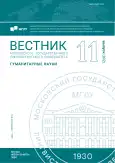MEANS OF CREATING THE I-AM-A-STRANGER IMAGE IN MEDIA DISCOURSE (ANALYSIS OF AN INTERVIEW WITH BRITISH PRINCE HENRY ON AMERICAN TV)
- Авторлар: Kosichenko E.F.1
-
Мекемелер:
- National Research University Moscow Power Engineering Institute
- Шығарылым: № 11(892) (2024)
- Беттер: 38-45
- Бөлім: Linguistics
- URL: https://bakhtiniada.ru/2542-2197/article/view/291956
- ID: 291956
Дәйексөз келтіру
Толық мәтін
Аннотация
The article analyzes a televised interview with British Prince Henry in a CBS show with the aim of revealing that media space is an eventful continuum that is structured according to the cyclical and binary principles, which creates conditions for socially presenting oneself as a stranger. Methods of structural, narrative and contextual analysis prove that the key means of creating the I-am-a-stranger image - in this case also a way of showing one’s negative attitude to a social event - are binary oppositions Self vs Family, Self vs Press, and the My-Mother-and-I analogy. The article analyzes a televised interview with British Prince Henry in a CBS show with the aim of revealing that media space is an eventful continuum that is structured according to the cyclical and binary principles, which creates conditions for socially presenting oneself as a stranger. Methods of structural, narrative and contextual analysis prove that the key means of creating the I-am-a-stranger image - in this case also a way of showing one’s negative attitude to a social event - are binary oppositions Self vs Family, Self vs Press, and the My-Mother-and-I analogy.
Авторлар туралы
Elena Kosichenko
National Research University Moscow Power Engineering Institute
Хат алмасуға жауапты Автор.
Email: KosichenkoYF@mpei.ru
Doctor of Philology (Dr. habil.), Associate Professor, Professor at the Department of Advertising, Public Relations and Linguistics National Research University “Moscow Power Engineering Institute”
РесейӘдебиет тізімі
- Volodina, M. N. (2018). «Media-culture»: pro et contra (from the perspective of domestic and foreign researchers). Political linguistics, 1(67), 10–18. (In Russ.)
- Guseinova I. A., Gorozhanov A. I. (2023). Connotated Image As A Way Of Constructing Informational Opposition In The Fictional And Publicistic Genre. Journal of Siberian federal university. Humanities & Social sciences, 16(6), 911–920. (In Russ.)
- Murejko, L. V. (2018). Social communication and mass media: towards a clarification of concepts. Bulletin of Moscow Region State University. Series: Philosophy, 2, 6–16. (In Russ.)
- Murejko, L. V. (2016). Mimesis and recursion: the problem of social communication in the epistemological aspect. St. Petersburg State Polytechnicаl University Journal: Humanities and Social Sciences, 4(255), 132–138. (In Russ.)
- Vlasyan, G. R. (2022). Discourse markers in British media discourse. Bulletin of Chelyabinsk State University, 9(467), 28–37. (In Russ.)
- Mohammed, S. J., Ahmed, M. B. (2018). Discourse Markers Functions in Social Interviews. Journal of Tikrit University for Humanities, 25(1), 353–374. https://doi.org/10.25130/jtuh.25.1.2018.14.
- Fu, Y., Ho, V. (2022). Discourse markers in TV interviews: a corpus-based comparative study of Chinese and the western media. Frontiers in Psychology. https://doi.org/10.25130/jtuh.25.1.2018.14.
- Neshenko, A. V. (2017). Self-presentation strategy in the interview (based on Angela Merkel interview). Cognitive studies of language, 29, 675–680. (In Russ.)
- Lavrova, S. Yu., Gonchar, A. A. (2021). Language representation of theatrical discursive practice in the genre of analytical interview. интервью. Bulletin of Cherepovetsk state university, 2(101), 71–83. (In Russ.)
- Kravchuk, E. R. (2021). Linguistic Image of a TV Hostess in Chat and Portrait Interviews. Bulletin of Kemerovo state university, 23, 4(88), 1032–1040. (In Russ.)
- Nikishin, V. I. (2021). Types of the interview. Approaches to creating analytical interview. Innovations. Science. Education, 35, 2557–2561. (In Russ.)
- Paramonov, P. M., Shmeleva, T. S. (2022). Interview-portrait as a special type of interview and object of translation (by the material of the interview with Calvin Harris). International Journal of Advanced Studies in Language and Communication, 1, 35–38. (In Russ.)
Қосымша файлдар










